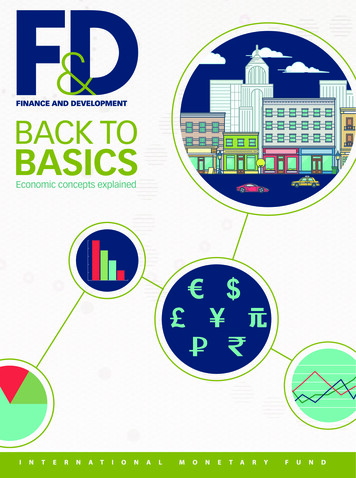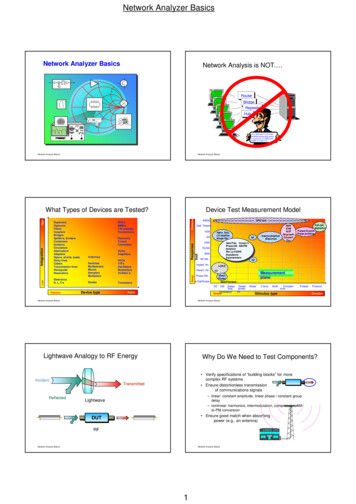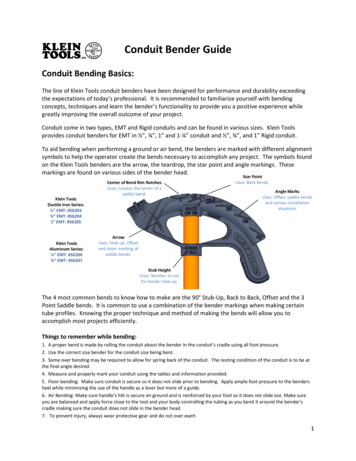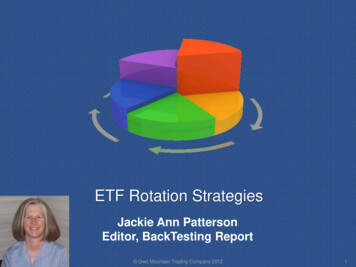
Transcription
BACK TOBASICSEconomic concepts explained
BACK TOBASICSEconomic concepts explained
2017 International Monetary FundCommissioning editor: James L. RoweManaging editor: Marina PrimoracProduction editor: Lijun LiCopy editor: Lucy MoralesCover design: IMF Multimedia Services
Back to Basics: Economic concepts explainedvForewordMaurice Obstfeld16Monetarism: Money Is Where It’s AtIts emphasis on money’s importance gained sway in the1970sSarwat Jahan and Chris PapageorgiouI. THE BIG PICTUREII. HOW ECONOMIES FUNCTION2What Is Capitalism?Free markets may not be perfect but they are probablythe best way to organize an economySarwat Jahan and Ahmed Saber Mahmud20What Is Direct Investment?Investors often seek profits from a long-term stake in aforeign operationTadeusz Galeza and James Chan4What Is Keynesian Economics?The central tenet of this school of thought is thatgovernment intervention can stabilize the economySarwat Jahan, Ahmed Saber Mahmud, and ChrisPapageorgiou22The Output Gap: Veering from PotentialEconomists look for the difference between what aneconomy is producing and what it could produceSarwat Jahan and Ahmed Saber Mahmud6Micro and Macro: The Economic DivideEconomics is split into two realms: the overall economyand individual marketsG. Chris Rodrigo248Economic Models: Simulations of RealityEconomists build simplified descriptions to enhancetheir understanding of how things workSam OuliarisStructural Policies: Fixing the Fabric ofthe EconomyMonetary and fiscal policies deal with short-termeconomic fluctuations, but an economy’s problemsoften go deeperKhaled Abdel-Kader26Money: At the Center of TransactionsWithout it, modern economies could not functionIrena Asmundson and Ceyda Oner28Price: The Language of ExchangeA price is the amount of money a buyer gives a sellerin exchange for a good or a service. But it can be morethan thatIrena Asmundson10Econometrics: Making Theory CountFor economic theory to be a useful tool forpolicymaking, it must be quantifiableSam Ouliaris12Supply and Demand: Why Markets TickBuyers and sellers meet and at the right price allproducts are soldIrena Asmundson30Gross Domestic Product: An Economy’sAllWhen it is growing, especially if inflation is not aproblem, workers and businesses are generally better offthan when it is not.Tim CallenInflation: Prices on the RiseInflation measures how much more expensive a set ofgoods and services has become over a certain period,usually a yearCeyda Oner32Unemployment: The Curse of JoblessnessThe number of people at work is generally closelyrelated to whether an economy is growing at areasonable rateCeyda Oner14Economics Concepts Explained FINANCE & DEVELOPMENTiii
34Recession: When Bad Times PrevailIt is a sustained period when economic output falls andunemployment risesStijn Claessens and M. Ayhan Kose54LIBOR: World Reference PointThe London interbank rate is used widely as abenchmark but has come under fireJohn Kiff36Fiscal Policy: Taking and Giving AwayGovernments use spending and taxing powers topromote stable and sustainable growthMark Horton and Asmaa El-Ganainy56Banks: At the Heart of the MatterInstitutions that match up savers and borrowers helpensure that economies function smoothlyJeanne Gobat38Externalities: Prices Do Not Capture AllCostsThere are differences between private returns or costsand the costs or returns to society as a wholeThomas Helbling58What Are Money Markets?They provide a means for lenders and borrowers tosatisfy their short-term financial needsRandall Dodd40International Trade: Commerce amongNationsNations are almost always better off when they buy andsell from one anotherBrad McDonald60Markets: Exchange or Over the CounterHow securities are traded plays a critical role in pricedetermination and stabilityRandall Dodd42444648What Are Real Exchange Rates?What is the value of a country’s goods against those ofanother country, a group of countries, or the rest of theworld, at the prevailing exchange rate?Luis A. V. CatãoPurchasing Power Parity: Weights MatterAt what rate would the currency of one country have tobe converted into that of another to buy the same goodsand services in each country?Tim CallenCapital Accounts: Liberalize or Not?There are both benefits and costs to easing restrictionson capital that flows across a country’s bordersM. Ayhan Kose and Eswar PrasadCurrent Account Deficits: Is There aProblem?There can be consequences when the amount a countryspends abroad is wildly different from what it receivesfrom the outside worldAtish Ghosh and Uma RamakrishnanIV. ECONOMICS IN ACTION64Financial Services: Getting the GoodsHow consumers and businesses acquire financialproducts such as loans and insuranceIrena Asmundson66Strategic ThinkingGame theory analyzes behavior when decisions musttake into account the potential actions of opponentsSarwat Jahan and Ahmed Saber Mahmud68Taxes in PracticeIt is hard to design a fair and efficient revenue systemRuud De Mooij and Michael Keen70Taxing PrinciplesMaking the best of a necessary evilRuud De Mooij and Michael Keen72Inflation Targeting: Holding the LineCentral banks use interest rates to steer price increasestoward a publicly announced goalSarwat Jahan74Regressions: An Economist ObsessionA basic statistical tool for distinguishing betweencorrelation and causalityRodney Ramcharan76What Are Remittances?For many countries, money transfers from citizensworking abroad are a lifeline for developmentDilip RathaIII. FINANCE52ivShadow Banks: Out of the Eyes ofRegulatorsMany financial institutions that act like banks are notsupervised like banks.Laura E. KodresFINANCE & DEVELOPMENT Back to Basics
FOREWORDPITY THE ECONOMIST. Financial stock prices have recovered fromthe great financial crisis of 2007–09—and, in some countries,are touching all-time highs. But the stock of economists remainsin the tank.Not only did we fail to see the financial crisis coming—asQueen Elizabeth II memorably observed during a 2008 visit tothe London School of Economics—but our economic policiesseem to most people not to have restored the global economyquite to its bloom of earlier decades.Thus, politicians these days scorn “experts” and encouragevoters to ignore them. They feel free to disavow even their owneconomic analysts in favor of convenient alternative views.Economic forecasting is widely derided as useless—or worse.How often have I been asked by a journalist, “Why should webelieve anything you say, when you were wrong about ?”There are sadly many ways to fill in that blank, and somecriticism of economics is well justified. Yet, just as it is important not to overstate what economics can do, it is critical not tounderstate it. Economics is far from a precise science—whowould expect to predict with any accuracy global outcomes thatdepend on the individual actions of about 5 billion working-ageindividuals, not to mention the intervention of natural andman-made disasters? At the same time, however, economicsprovides an essential tool for understanding, and to some degreeshaping, those events.The articles in this collection, all from the InternationalMonetary Fund’s quarterly magazine Finance & Developmentand updated in 2017, illustrate the rich diversity of questionsthat economics can illuminate. The best economic analysisclarifies thought: it is a mental discipline that helps make senseof complex events, ranging from famines, to bank runs, to housing shortages. It can proceed from the bottom up—focusingon the decisions of individuals and how they hang togetherat the economy level—or from the top down—reminding ushow an economy’s resources, its technology, and its tradingopportunities limit what its people and government can consume over time.As you will see reading these pages, economics is less thana science—which is what gets economists into trouble—but,looked at in another way, it is more. One of the architects of theInternational Monetary Fund, John Maynard Keynes, calledeconomics “an easy subject at which few excel . The paradoxfinds its explanation, perhaps, in that the master-economist mustpossess a rare combination of gifts. He must be mathematician,historian, statesman, philosopher—in some degree.” It may bethe curse of economists that their subject cannot be reducedto a routine technical exercise—like dentistry, to use anotherexample of Keynes’s. But that is also what makes economics sofascinating.— Maurice ObstfeldEconomic Counsellor andDirector of Research DepartmentInternational Monetary FundEconomics Concepts Explained FINANCE & DEVELOPMENTv
ITHE BIG PICTURE
What Is Capitalism?Free markets may not be perfect but they are probably the best way to organize an economySarwat Jahan and Ahmed Saber MahmudCAPITALISM is often thought of as an economic system in whichprivate actors own and control property in accord with theirinterests, and demand and supply freely set prices in marketsin a way that can serve the best interests of society.The essential feature of capitalism is the motive to make aprofit. As Adam Smith, the 18th century philosopher and fatherof modern economics, said: “It is not from the benevolence ofthe butcher, the brewer, or the baker that we expect our dinner,but from their regard to their own interest.” Both parties to avoluntary exchange transaction have their own interest in theoutcome, but neither can obtain what he or she wants withoutaddressing what the other wants. It is this rational self-interestthat can lead to economic prosperity.In a capitalist economy, capital assets—such as factories,mines, and railroads—can be privately owned and controlled,labor is purchased for money wages, capital gains accrue toprivate owners, and prices allocate capital and labor betweencompeting uses (see “Supply and Demand,” p. 12).Although some form of capitalism is the basis for nearly alleconomies today, for much of the past century it was but oneof two major approaches to economic organization. In theother, socialism, the state owns the means of production, andstate-owned enterprises seek to maximize social good ratherthan profits.Pillars of capitalismCapitalism is founded on the following pillars: private property, which allows people to own tangibleassets such as land and houses and intangible assets such asstocks and bonds; self-interest, through which people act in pursuit of theirown good, without regard for sociopolitical pressure. Nonetheless, these uncoordinated individuals end up benefitingsociety as if, in the words of Smith’s 1776 Wealth of Nations,they were guided by an invisible hand; competition, through firms’ freedom to enter and exitmarkets, maximizes social welfare, that is, the joint welfareof both producers and consumers; a market mechanism that determines prices in a decentralized manner through interactions between buyers andsellers—prices, in return, allocate resources, which naturally2FINANCE & DEVELOPMENT Back to Basicsseek the highest reward, not only for goods and services butfor wages as well; freedom to choose with respect to consumption, production, and investment—dissatisfied customers can buy differentproducts, investors can pursue more lucrative ventures, workerscan leave their jobs for better pay; and limited role of government, to protect the rights of privatecitizens and maintain an orderly environment that facilitatesproper functioning of markets.The extent to which these pillars operate distinguishes variousforms of capitalism. In free markets, also called laissez-faireeconomies, markets operate with little or no regulation. Inmixed economies, so called because of the blend of markets andgovernment, markets play a dominant role, but are regulatedto a greater extent by government to correct market failures,such as pollution and traffic congestion; promote social welfare;and for other reasons, such as defense and public safety. Mixedcapitalist economies predominate today.The many shades of capitalismEconomists classify capitalism into different groups usingvarious criteria. Capitalism, for example, can be simply slicedinto two types, based on how production is organized. In liberalmarket economies, the competitive market is prevalent and thebulk of the production process takes place in a decentralizedmanner akin to the free-market capitalism seen in the UnitedStates and the United Kingdom. Coordinated market economies,on the other hand, exchange private information throughnon–market institutions such as unions and business associations—as in Germany and Japan (Hall and Soskice 2001).More recently, economists have identified four types of capitalism distinguished according to the role of entrepreneurship(the process of starting businesses) in driving innovation andthe institutional setting in which new ideas are put into placeto spur economic growth (Baumol, Litan, and Schramm 2007).In state-guided capitalism, the government decides which sectors will grow. Initially motivated by a desire to foster growth,this type of capitalism has several pitfalls: excessive investment,picking the wrong winners, susceptibility to corruption, anddifficulty withdrawing support when it is no longer appropriate. Oligarchic capitalism is oriented toward protecting and
I. THE BIG PICTUREenriching a very narrow fraction of the population. Economicgrowth is not a central objective, and countries with this varietyhave a great deal of inequality and corruption.Big-firm capitalism takes advantage of economies of scale. Thistype is important for mass production of products. Entrepreneurial capitalism produces breakthroughs like the automobile,telephone, and computer. These innovations are usually theproduct of individuals and new firms. However, it takes bigfirms to mass-produce and market new products, so a mix ofbig-firm and entrepreneurial capitalism seems best. This isthe kind that characterizes the United States more than anyother country.The Keynesian critiqueDuring the Great Depression of the 1930s, the advancedcapitalist economies suffered widespread unemployment. Inhis 1936 General Theory of Employment, Interest, and Money,British economist John Maynard Keynes argued that capitalismstruggles to recover from slowdowns in investment because acapitalist economy can remain indefinitely in equilibrium withhigh unemployment and no growth. Keynesian economicschallenged the notion that laissez-faire capitalist economiescould operate well on their own without state interventionto promote aggregate demand and fight high unemploymentand deflation of the sort seen during the 1930s. He postulatedthat government intervention (by cutting taxes and increasinggovernment spending) was needed to pull the economy outof the recession (see “What Is Keynesian Economics?” p. 4).These actions sought to temper the boom and bust of the business cycle and to help capitalism recover following the GreatDepression. Keynes never intended to replace the market-basedeconomy with a different one; he asserted only that periodicgovernment intervention was necessary.The forces that generally lead to the success of capitalismcan also usher in its failure. Free markets can flourish onlywhen governments set the rules that govern them—such aslaws that ensure property rights—and support markets withproper infrastructure, such as roads and highways to movegoods and people. Governments, however, may be influencedby organized private interests that try to leverage the power ofregulations to protect their economic position at the expenseof the public interest—for example, by repressing the samefree market that bred their success.Thus, according to Rajan and Zingales (2003), society must“save capitalism from the capitalists”—that is, take appropriatesteps to protect the free market from powerful private intereststhat seek to impede its efficient functioning. When politicalinterest and the capitalist class combine, “crony capitalism” mayemerge, and nepotism will be more rewarding than efficiency.The concentration of ownership of productive assets must belimited to ensure competition. And, because competitionbegets winners and losers, losers must be compensated. Freetrade and strong competitive pressure on incumbent firms willalso keep powerful interests at bay. The public needs to see thevirtues of free markets and oppose government interventionin the market to protect powerful incumbents at the expenseof overall economic prosperity.The essential feature of capitalism isthe motive to make a profit.Economic growth under capitalism may have far surpassedthat of other economic systems, but inequality remains one ofits most controversial attributes. Do the dynamics of privatecapital accumulation inevitably lead to the concentration ofwealth in fewer hands, or do the balancing forces of growth,competition, and technological progress reduce inequality?Economists have taken various approaches to finding thedriver of economic inequality. The most recent study analyzesa unique collection of data going back to the 18th centuryto uncover key economic and social patterns (Piketty 2014).It finds that in contemporary market economies, the rate ofreturn on investment frequently outstrips overall growth. Withcompounding, if that discrepancy persists, the wealth held byowners of capital will increase far more rapidly than other kindsof earnings (wages, for example), eventually outstripping themby a wide margin. Although this study has as many critics asadmirers, it has added to the debate on wealth distributionin capitalism and reinforced the belief among many that acapitalist economy must be steered in the right direction bygovernment policies and the general public to ensure thatSmith’s invisible hand continues to work in society’s favor.SARWAT JAHAN is a senior economist in the IMF’s Asia and Pacific Department, and AHMED SABER MAHMUD is associate director in the AppliedEconomics Program at Johns Hopkins University.References:Baumol, William J., Robert E. Litan, and Carl J. Schramm. 2007. Good Capitalism, Bad Capitalism, and theEconomics of Growth and Prosperity. New Haven, Connecticut: Yale University Press.Hall, Peter A., and David Soskice, eds. 2001. Varieties of Capitalism: The Institutional Foundations ofComparative Advantage. New York: Oxford University Press.Piketty, Thomas. 2014. Capital in the Twenty-First Century. Cambridge, Massachusetts: Belknap Press.Rajan, Raghuram, and Luigi Zingales. 2003. Saving Capitalism from the Capitalists: Unleashing the Powerof Financial Markets to Create Wealth and Spread Opportunity. New York: Crown Publishing Group.Economics Concepts Explained FINANCE & DEVELOPMENT3
What Is Keynesian Economics?The central tenet of this school of thought is that government intervention can stabilize the economySarwat Jahan, Ahmed Saber Mahmud, and Chris PapageorgiouDURING THE GREAT DEPRESSION of the 1930s, existing economictheory was unable either to explain the causes of the severeworldwide economic collapse or to provide an adequate publicpolicy solution to jump-start production and employment.British economist John Maynard Keynes spearheaded a revolution in economic thinking that overturned the then-prevailingidea that free markets would automatically provide full employment—that is, that everyone who wanted a job would have oneas long as workers were flexible in their wage demands (see box).The main plank of Keynes’s theory, which has come to bear hisname, is the assertion that aggregate demand—measured asthe sum of spending by households, businesses, and the government—is the most important driving force in an economy.Keynes further asserted that free markets have no self-balancingmechanisms that lead to full employment. Keynesian economistsjustify government intervention through public policies that aimto achieve full employment and price stability.The revolutionary ideaKeynes argued that inadequate overall demand could leadto prolonged periods of high unemployment. An economy’soutput of goods and services is the sum of four components:consumption, investment, government purchases, and netexports (the difference between what a country sells to and buysfrom foreign countries). Any increase in demand has to comefrom one of these four components. But during a recession,strong forces often dampen demand as spending goes down.For example, during economic downturns uncertainty oftenerodes consumer confidence, causing them to reduce theirspending, especially on discretionary purchases like a houseor a car. This reduction in spending by consumers can resultin less investment spending by businesses, as firms respondto weakened demand for their products. This puts the task ofincreasing output on the shoulders of the government. According to Keynesian economics, state intervention is necessary tomoderate the booms and busts in economic activity, otherwiseknown as the business cycle.There are three principal tenets in the Keynesian descriptionof how the economy works: Aggregate demand is influenced by many economic decisions—public and private. Private sector decisions can sometimeslead to adverse macroeconomic outcomes, such as reduction in4FINANCE & DEVELOPMENT Back to Basicsconsumer spending during a recession. These market failuressometimes call for active policies by the government, such as afiscal stimulus package (explained below). Therefore, Keynesianeconomics supports a mixed economy guided mainly by theprivate sector but partly operated by the government. Prices, and especially wages, respond slowly to changes insupply and demand, resulting in periodic shortages and surpluses,especially of labor. Changes in aggregate demand, whether anticipated orunanticipated, have their greatest short-run effect on real output and employment, not on prices. Keynesians believe that,because prices are somewhat rigid, fluctuations in any component of spending—consumption, investment, or governmentexpenditures—cause output to change. If government spendingincreases, for example, and all other spending componentsremain constant, then output will increase. Keynesian modelsof economic activity also include a multiplier effect; that is,output changes by some multiple of the increase or decrease inspending that caused the change. If the fiscal multiplier is greaterthan one, then a one dollar increase in government spendingwould result in an increase in output greater than one dollar.Stabilizing the economyNo policy prescriptions follow from these three tenets alone.What distinguishes Keynesians from other economists is theirbelief in activist policies to reduce the amplitude of the business cycle, which they rank among the most important of alleconomic problems.Rather than seeing unbalanced government budgets as wrong,Keynes advocated so-called that act against the direction of thebusiness cycle. For example, Keynesian economists would advocate deficit spending on labor-intensive infrastructure projectsto stimulate employment and stabilize wages during economicdownturns. They would raise taxes to cool the economy andprevent inflation when there is abundant demand-side growth.Monetary policy could also be used to stimulate the economy—for example, by reducing interest rates to encourage investment.The exception occurs during a liquidity trap, when increases inthe money stock fail to lower interest rates and, therefore, do notboost output and employment.Keynes argued that governments should solve problems inthe short run rather than wait for market forces to fix things
I. THE BIG PICTUREover the long run, because, as he wrote, “In the long run, weare all dead.” This does not mean that Keynesians advocateadjusting policies every few months to keep the economy atfull employment. In fact, they believe that governments cannotknow enough to fine-tune successfully.Keynesianism evolvesEven though his ideas were widely accepted while Keynes wasalive, they were also scrutinized and contested by several contemporary thinkers. Particularly noteworthy were his argumentswith the Austrian School of Economics, whose adherents believedthat recessions and booms are a part of the natural order andthat government intervention only worsens the recovery process.Keynesian economics dominated economic theory and policy after World War II until the 1970s, when many advancedeconomies suffered both inflation and slow growth, a conditiondubbed “stagflation.” Keynesian theory’s popularity waned thenbecause it had no appropriate policy response for stagflation.Monetarist economists doubted the ability of governments toregulate the business cycle with fiscal policy and argued thatjudicious use of monetary policy (essentially controlling thesupply of money to affect interest rates) could alleviate the crisis(see “Monetarism,” p. 16). Members of the monetarist schoolalso maintained that money can have an effect on output inKEYNES THE MASTERKeynesian economics gets its name, theories, and principlesfrom British economist John Maynard Keynes (1883–1946),who is regarded as the founder of modern macroeconomics.His most famous work, The General Theory of Employment,Interest and Money, was published in 1936. But its 1930 precursor, A Treatise on Money, is often regarded as more importantto economic thought. Until then economics analyzed onlystatic conditions—essentially doing detailed examination ofa snapshot of a rapidly moving process. Keynes, in Treatise,created a dynamic approach that converted economics intoa study of the flow of incomes and expenditures. He openedup new vistas for economic analysis.In The Economic Consequences of the Peace in 1919, Keynespredicted that the crushing conditions the Versailles peacetreaty placed on Germany to end World War I would leadto another European war.He remembered the lessons from Versailles and from theGreat Depression when he led the British delegation at the1944 Bretton Woods conference—which set down rules toensure the stability of the international financial system andfacilitated the rebuilding of nations devastated by World WarII. Along with US Treasury official Harry Dexter White,Keynes is considered the intellectual founding father of theInternational Monetary Fund and the World Bank, whichwere created at Bretton Woods.the short run but believed that in the long run, expansionarymonetary policy leads to inflation only. Keynesian economistslargely adopted these critiques, adding to the original theory abetter integration of the short and the long run and an understanding of the long-run neutrality of money—the idea that achange in the stock of money affects only nominal variables inthe economy, such as prices and wages, and has no effect onreal variables, like employment and output.The main plank of Keynes’s theoryis that aggregate demand is themost important driving force in aneconomy.Both Keynesians and monetarists came under scrutiny withthe rise of the new classical school during the mid-1970s. Thenew classical school asserted that policymakers are ineffectivebecause individual market participants can anticipate the changesfrom a policy and act in advance to counteract them. A newgeneration of Keynesians that arose in the 1970s and 1980sargued that even though individuals can anticipate correctly,aggregate markets may not clear instantaneously; therefore,fiscal policy can still be effective in the short run.The global financial crisis of 2007–08 caused a resurgencein Keynesian thought. It was the theoretical underpinnings ofeconomic policies in response to the crisis by many governments,including in the United States and the United Kingdom. As theglobal recession was unfurling in late 2008, Harvard professorN. Gregory Mankiw wrote in the New York Times, “If you weregoing to turn to only one economist to understand the problemsfacing the economy, there is little doubt that the economist wouldbe John Maynard Keynes. Although Keynes died more than ahalf-century ago, his diagnosis of recessions and depressionsremains the foundation of modern macroeconomics. Keyneswrote, ‘Practical men, who believe themselves to be quite exemptfrom any intellectual influence, are usually the slave of somedefunct economist.’ In 2008, no defunct economist is moreprominent than Keynes himself.”But the 2007–08 crisis also showed that Keynesian theoryhad to better include the role of the financial system. Keynesianeconomists are rectifying that omission by integrating the realand financial sectors of the economy.SARWAT JAHAN is a senior economist in the IMF’s Asia and Pacific Department, AHMED SABER MAHMUD is the associate director of appliedEconomics at Johns Hopkins University, and CHRIS PAPAGEORGIOU is adeputy division chief in the IMF’s Research Department.Economics Concepts Explained FINANCE & DEVELOPMENT5
Micro and Macro: The EconomicDivideEconomics is split into two realms: the overall economy and individual marketsG. Chris RodrigoPHYSICISTS LOOK AT the big world of planets, stars, galaxies, andgravity. But they also study the minute world of atoms and thetiny particles that comprise those atoms.Economists also look at two realms. There is big-picturemacroeconomics, which is concerned with how the overalleconomy works. It studies such things as employment, grossdomestic product, and inflation—the stuff of news stories andgovernment policy debates. Little-picture microeconomics isconcerned with how supply and demand interact in individualmarkets for goods and services.In macroeconomics, the subject is typically a nation—howall markets interact to generate big phenomena that economistscall aggregate variables. In the realm of microeconomics, theobject of analysis is a single market—for example, whether pricerises in the automobile or oil industries are driven by supply ordemand changes. The government is a major object of analysisin macroeconomics—for example, studying the role it plays incontributing to overall economic growth or fighting inflation.Macroeconomics often extends to the international spherebecause domestic markets are linked to foreign markets
Free markets may not be perfect but they are probably the best way to organize an economy Sarwat Jahan and Ahmed Saber Mahmud CAPITALISM is often thought of as an economic system in which private actors own and control property in accord with their inte











